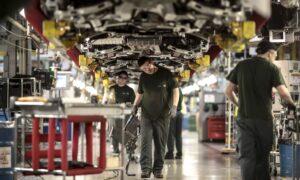Jaguar Land Rover is lagging way behind rival UK carmakers in its recovery from the pandemic, with 3,000 workers still furloughed and a key factory running at only a fraction of capacity, according to confidential production plans.
Every UK car factory shut its doors in March as the UK’s coronavirus lockdown began, and manufacturers relied heavily on the coronavirus job retention scheme, which supported the salaries of furloughed workers.
However, with the furlough scheme closing at the end of the month, every other UK carmaker now has fewer than 80 workers still furloughed, leaving JLR as a significant outlier, according to new figures.
JLR, owned by the Indian conglomerate Tata, is planning between 100 and 200 job cuts via a voluntary redundancy programme as the furlough scheme closes.
Other workers are expected to return, although the carmaker said a decision has yet to be reached on how to use the government’s new job support scheme, which will pay up to 22% of the salaries of employees on reduced hours.
The carmaker could be in line for up to £20m from the government’s job retention bonus in February it if keeps on all of the 20,000 workers who were previously furloughed.
JLR’s continued reliance on the furlough subsidies adds to concerns about the financial health of the UK’s largest carmaker, even as sales recover from the worst of the pandemic.
Most of its UK factories are now running two shifts, meaning they are returning to something like pre-pandemic production. However, production figures obtained by the Guardian suggest that JLR is planning to use only a small part of its capacity at its Castle Bromwich plant in the year to March, adding to concerns over the future of jobs at the West Midlands factory.
JLR plans to produce only around 11,000 cars in the year to March at the plant, including about 4,000 of its F-Type sports car and about 3,500 each for the XE and XF saloon cars. In the 2019 calendar year the factory produced 35,000 cars, while in 2013 it made 80,000, according to MarkLines, an industry data provider.
Fewer than 300 XEs are expected to be produced per month for the rest of 2020, although output will increase gradually as it launches its latest version. Sales of the model have previously disappointed, and JLR last week withdrew the model from the US market.
The limited production plans come at a sensitive time, with newly installed chief executive Thierry Bolloré understood to be reviewing all of JLR’s investment plans, including a £1bn investment in Castle Bromwich to build a new electric version of the XJ, Jaguar’s flagship vehicle and the car of choice for a long line of British prime ministers.
JLR must urgently cut its carbon dioxide emissions – the key benefit of electric cars – to avoid possible fines from the EU. Analysis by Transport & Environment, a campaign group, showed that JLR will have to reduce the average emissions of the cars it sells by more than any European carmaker. It could also pay another carmaker to borrow emissions credits.
Bolloré, Renault chief executive until last year, also has to contend with the possibility of a no-deal Brexit on 1 January, which could cause chaos with the overnight imposition of expensive tariffs on cars and parts, as well as new customs paperwork.
David Bailey, professor of business economics at the University of Birmingham, said he had concerns over the future of the Castle Bromwich plant in the event of a no-deal Brexit. JLR could in theory move some production to its plant in Nitra, Slovakia.
A Jaguar spokeswoman said it was too early to speculate about Bolloré’s plans. She added that “any views on the impact of Brexit are just speculation”.
On production plans, the spokeswoman said: “Naturally, in these uncertain times, we have had to adjust some programmes.”
